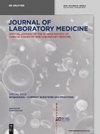奥格斯堡纵向血浆研究(ALPS)的概念和可行性--基于液体活检对实体癌患者进行全面纵向监测的前瞻性试验
IF 1.8
4区 医学
Q4 MEDICAL LABORATORY TECHNOLOGY
引用次数: 0
摘要
目的 液体活检(LBx)为恶性疾病的诊断、预后和预测提供洞察力,在肿瘤负荷、肿瘤异质性和克隆进化方面具有广阔的应用前景。方法 ALPS 是一项针对转移性癌症患者的前瞻性试验,包括依次收集 LBx 样品、肿瘤组织、放射成像数据、临床信息和患者报告结果。根据每位患者的分期间隔收集外周血血浆,并使用肿瘤个体化分析测序(CAPP-seq)对枸橼酸瘤细胞衍生的ctDNA进行分析。结果 从 2021 年 4 月到 2023 年 10 月,共有 419 名患者入组。共收集了 1,293 份 LBx 样本,其中 419 份样本(100%)在研究开始时采集,在本次中期分析的 30 个月随访期间平均采集了 3 份样本(范围为 1-12)。基线时有 380 份组织活检 (TBx) 样本(90.7%),39.6% 的患者在随访时有≥1 份 TBx 样本。在 ALPS 中,肺癌患者最多(147 人),其次是结直肠癌(38 人)、前列腺癌(31 人)和胃食管癌(28 人)。平均可分离出 12.0 纳克/毫升血浆无细胞 DNA(cfDNA)。对 60 名患者的 110 份样本进行了首次 CAPP-seq 分析,结果显示检测灵敏度为 0.1%。结论 ALPS 的首次中期分析证实了对 LBx 进行全面纵向评估的可行性,并证明了 ctDNA 评估的适用性。本文章由计算机程序翻译,如有差异,请以英文原文为准。
Concept and feasibility of the Augsburg longitudinal plasma study (ALPS) – A prospective trial for comprehensive liquid biopsy-based longitudinal monitoring of solid cancer patients
Objectives Liquid biopsy (LBx) provides diagnostic, prognostic and predictive insights for malignant diseases and offers promising applications regarding tumor burden, tumor heterogeneity and clonal evolution. Methods ALPS is a prospective trial for patients with metastatic cancer that comprises sequential collection of LBx samples, tumor tissue, radiological imaging data, clinical information and patient-reported outcomes. Peripheral blood plasma is collected based on the individual patient’s staging intervals and LBx-derived ctDNA analyses are performed using CAncer Personalized Profiling sequencing (CAPP-seq). Results From April 2021 to October 2023, 419 patients have been enrolled. A total of 1,293 LBx samples were collected, 419 samples (100 %) at the beginning of the study and an average of 3 (range 1–12) during the 30-month follow-up period of the current interim analysis. 380 tissue biopsy (TBx) samples (90.7 %) were available at baseline and 39.6 % had ≥1 TBx samples at follow-up. Lung cancer patients are most prevalent in ALPS (n=147), followed by colorectal (n=38), prostate (n=31) and gastroesophageal cancer (n=28). On average, 12.0 ng/mL plasma cell-free DNA (cfDNA) could be isolated. First CAPP-seq analyses in 60 patients comprised 110 samples and demonstrated a detection sensitivity of 0.1 %. Conclusions The first interim analysis of ALPS confirms feasibility for comprehensive longitudinal evaluation of LBx and demonstrates suitability for ctDNA evaluation.
求助全文
通过发布文献求助,成功后即可免费获取论文全文。
去求助
来源期刊

Journal of Laboratory Medicine
Mathematics-Discrete Mathematics and Combinatorics
CiteScore
2.50
自引率
0.00%
发文量
39
审稿时长
10 weeks
期刊介绍:
The Journal of Laboratory Medicine (JLM) is a bi-monthly published journal that reports on the latest developments in laboratory medicine. Particular focus is placed on the diagnostic aspects of the clinical laboratory, although technical, regulatory, and educational topics are equally covered. The Journal specializes in the publication of high-standard, competent and timely review articles on clinical, methodological and pathogenic aspects of modern laboratory diagnostics. These reviews are critically reviewed by expert reviewers and JLM’s Associate Editors who are specialists in the various subdisciplines of laboratory medicine. In addition, JLM publishes original research articles, case reports, point/counterpoint articles and letters to the editor, all of which are peer reviewed by at least two experts in the field.
 求助内容:
求助内容: 应助结果提醒方式:
应助结果提醒方式:


